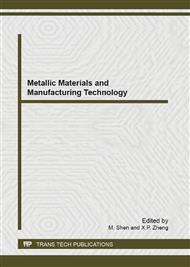p.11
p.15
p.20
p.25
p.30
p.34
p.38
p.41
p.45
The Influences of Alternating Magnetic Field to the Microstructure and Mechanical Property of Diamond Agglomerations
Abstract:
By numerical and experimental methods, heat alternating magnetic treatment of diamond agglomerations were researched, the microstructure and mechanical properties before and after treatment were also analysed comparatively. The numerical analysis shows: the alternating magnetic field stress is bound to make solid-state microstructure change, this intensified magnetic shock can broke dendrites and tangles organization within the organization and enables organization uniform, dense. The experiments indicate: After heat alternating magnetic treatment, the HRB hardness of test pieces matrix is improved 4.34, impact toughness enhanced more than 25%, matrix organization became uniformity and density. Results revealed that alternating magnetic treatment can be an effective method for improving the performance of the diamond agglomeration.
Info:
Periodical:
Pages:
30-33
Citation:
Online since:
September 2013
Authors:
Price:
Сopyright:
© 2013 Trans Tech Publications Ltd. All Rights Reserved
Share:
Citation:


